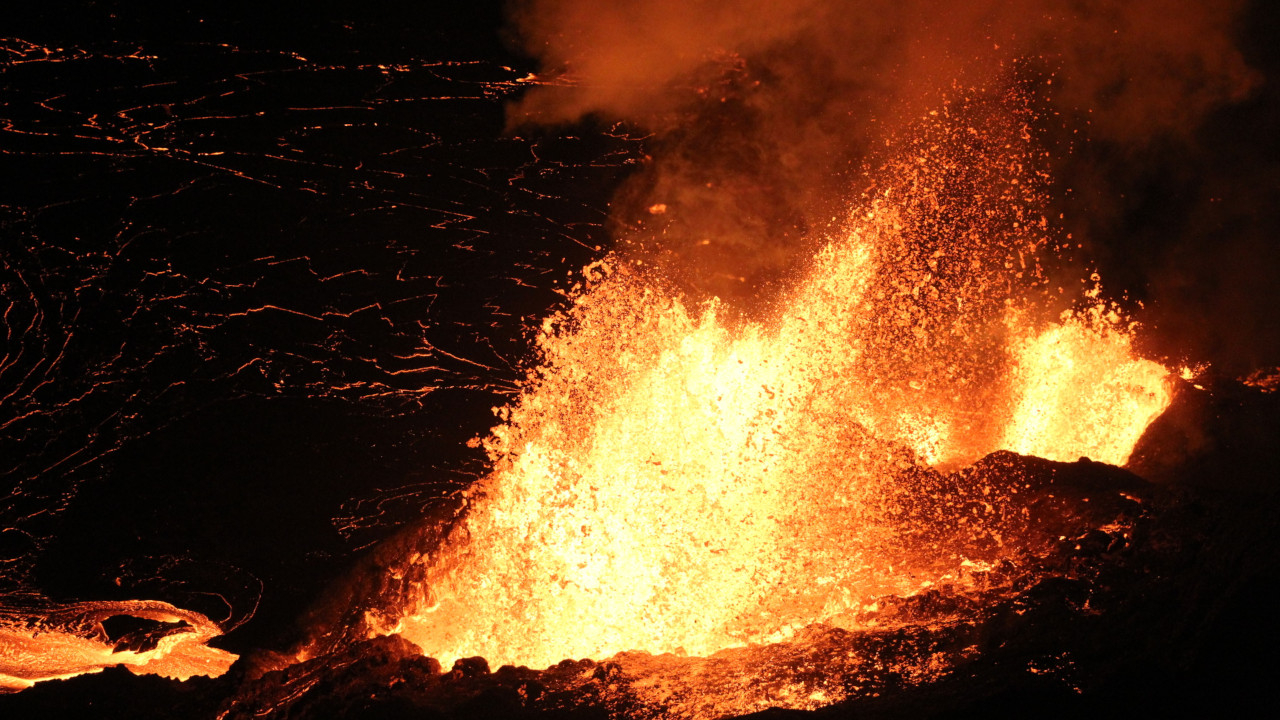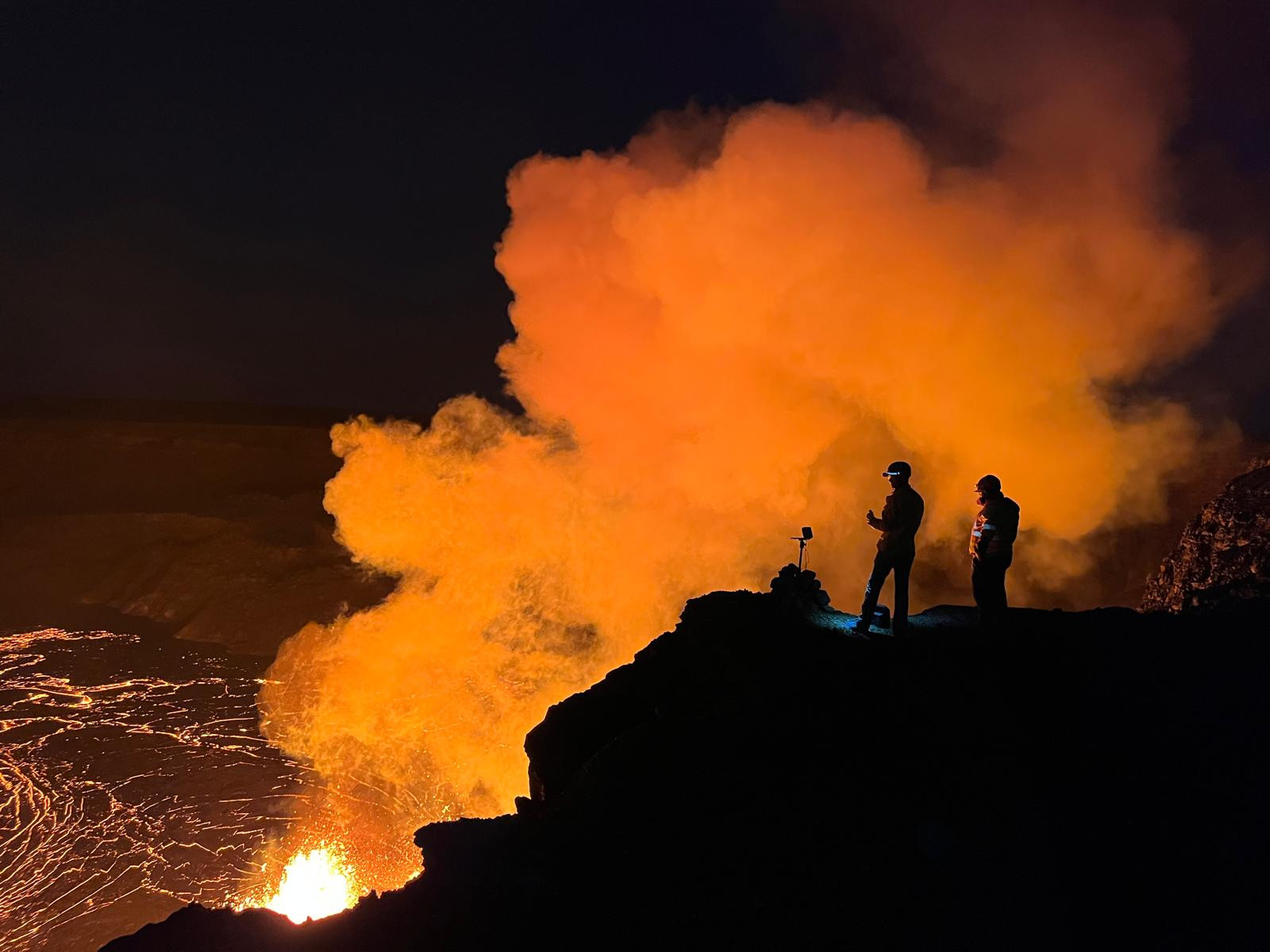
USGS: “The Kīlauea Halema‘uma‘u eruption resumed with the start of episode 9 the morning of February 11, 2025. Both the north and south vent were active the evening of February 11, with the north vent lava fountain reaching heights of 50-60 meters (160-200 feet) and a max height of 75 meters (250 feet) at 7:40 p.m. HST. The south vent ranges between 25-30 meters (80-100 feet). Outpouring lava continues to flow on the caldera floor. This picture is taken from the west crater rim looking southeast.” (USGS photo by H Winslow)
UPDATE – (10 a.m. HST) – The ongoing eruption of Kīlauea paused this morning, February 12, when Episode 9 ended at 8:43 a.m. HST.
From the USGS Hawaiian Volcano Observatory:
Episode 9 ended at 8:43 a.m. HST this morning, February 12, after 22 and a half hours of lava fountaining.
Fountains began erupting from the north vent at 10:16 a.m. HST yesterday, February 11, and slow effusion of lava began from the south vent shortly afterward, at around 10:50 a.m. HST. Vigorous, sustained fountains from the north vent reached heights of up to 330 feet (100 meters) during the initial hours of episode 9 and were averaging heights of up to 160-200 feet (50-60 meters) last night, while bifurcated south vent fountains were lower, reaching 80-100 feet (25-30 meters) high last night, February 11. This morning, February 12, effusion rates were decreased compared to yesterday. Fountains observed before 8:30 a.m. HST this morning were lower than yesterday and variable in height, reaching 100-150 feet (30-50 meters). Fountains continued to slowly drop until the vents started shutting down around 8:30 a.m. HST. Lava fountaining stopped from the north vent at 8:30 a.m. HST followed by large decrease in vigor of fountains from the south vent a few minutes later. A small amount of lava continued to erupt from the south vent until at 8:43 a.m. HST, when episode 9 ended.
New lava flows erupted during episode 9 traveled approximately half a mile (about a kilometer) across the floor of Halemaʻumaʻu and covered approximately 50-60% of Halemaʻuʻmaʻu floor.
The Uēkahuna tiltmeter (UWD) switched from inflation to deflation, and seismic tremor increased, at about the same time lava flows began erupting onto the crater floor yesterday morning, February 11, at 10:16 a.m. HST. UWD recorded nearly 13 microradians of deflationary tilt during the episode 9 eruption but switched to inflation as the vents shut down around 8:30 a.m. HST. Seismic tremor remains elevated but decreased with the end of episode 9. No significant earthquakes were recorded in the summit region over the past 24 hours.
Wind conditions and the timing of episode 9 prevented accurate measurements of the sulfur dioxide (SO2) emission rate. SO2 emission rates during episode 9 are estimated to have been 10,000 t/d or higher based on emissions measured during earlier episodes. During eruptive pauses, SO2 emission rates are lower and typically around 1,000 t/d.
Strands of volcanic glass known as Pele’s Hair have been reported on surfaces throughout the summit area of Hawai’i Volcanoes National Park and surrounding communities.
Analysis:
The current eruption is marked by episodic fountaining not seen in any of the other Halemaʻumaʻu eruptions since 2020. Fountains and lava flows have erupted from two vents that we refer to as the north vent and south vent. The previous episodes lasted from a few hours to over a week. Each fountaining episode has been accompanied by strong deflation of the summit region. Pauses between the fountaining episodes have been marked by an immediate change from deflation to inflation as the magma chamber recharges and repressurizes.
Episode 9 lasted for 22 hours and 30 minutes. The rapid change from deflation to inflation at the same time the eruption paused suggests another episode will take place but there is not enough information to establish a likely time window for the next episode this morning.

USGS: “On the evening of February 11, 2025, USGS geologists deployed to the rim of Kaluapele to observe and document episode nine of the ongoing December 2024–February 2025 Halema‘uma‘u eruption at the summit of Kīlauea. Near the KWcam site, USGS geologists checked on timelapse cameras that have been capturing the ongoing eruption since December 23, 2024. Tall fountain heights from this latest episode of the eruption pose a threat to the cameras, which can begin to warp and melt if the erupting lava fountains reach high enough to get close to them.” (USGS photo by J. Barnett)
(BIVN) – 7:30 a.m. HST – Episode 9 in the ongoing summit eruption of Kīlauea volcano on Hawaiʻi island continues. The USGS Volcano Alert Level for Kīlauea remains at WATCH.
Episode 9 began on Tuesday morning, February 11, with high lava fountains producing flows that covered part of Halemaʻumaʻu crater floor.
Tuesday evening, the USGS Hawaiian Volcano Observatory reported 160 to 200 feet high lava fountains continued from the north vent within Halemaʻumaʻu crater, while fountains at the south vent were 80-100 feet high.
This morning, lava fountain heights are much lower than they were on Tuesday.
All activity is confined to the Kīlauea summit caldera within Hawaiʻi Volcanoes National Park.

by Big Island Video News7:31 am
on at
STORY SUMMARY
HAWAIʻI VOLCANOES NATIONAL PARK - Eruptive Episode 9 continues at the summit of Kīlauea volcano, with active lava flowing onto the crater floor.